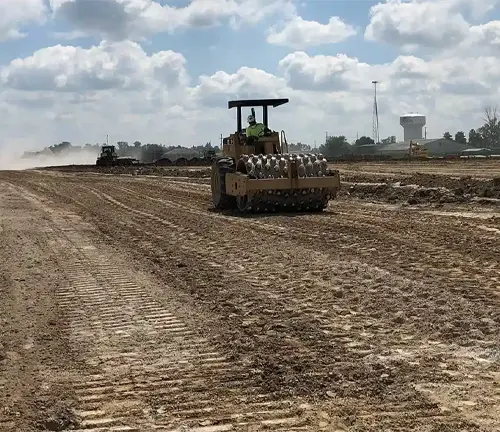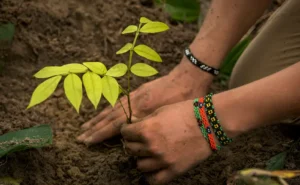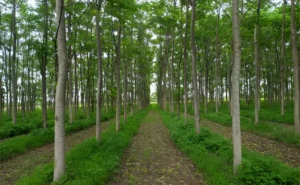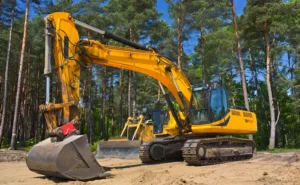Restoring Balance: How Native Tree Planting Supports Wildlife Habitats
- August 15, 2024
- 0 comment
Restoring balance in our natural environments is very important, especially with the fast changes happening in the environment like climate change, habitat destruction, and pollution. These challenges put at risk the delicate ecosystems that support wildlife and human life. One good way to restore balance is by planting native trees.
Native trees are species that have evolved in a specific region and are well-suited to the local climate, soil, and wildlife. They play a key role in supporting wildlife habitats by providing food, shelter, and places for animals to have their babies. Native trees also provide many benefits to the environment, like improving soil quality, controlling water cycles, and making the air cleaner.
By encouraging different types of plants and animals to thrive, native tree planting helps restore ecological balance and also makes ecosystems stronger, allowing them to better handle environmental stresses. In this article, we will look at the benefits of native tree planting, how it helps wildlife habitats, the challenges it faces, and effective ways to make it successful.
Benefits of Native Tree Planting
Native tree planting offers numerous benefits, making it an essential practice in ecological restoration efforts.
Ecosystem Restoration
Native trees are integral to restoring ecosystems that have been degraded by human activities such as deforestation and urbanization. By reintroducing native species, ecosystems can regain their natural structure and function, supporting a diverse range of wildlife. Native trees help to recreate the natural habitats that have been lost, providing a foundation for the recovery of native plant and animal species.

Soil Stabilization
The roots of native trees help stabilize soil, preventing erosion and promoting healthy soil structure. This stabilization is vital for maintaining the integrity of various ecosystems, particularly in areas prone to erosion and landslides. Native trees have evolved to thrive in the local soil conditions, and their deep root systems help to anchor the soil and prevent it from being washed away by heavy rains or strong winds.

Water Cycle Regulation
Native trees play a significant role in regulating the water cycle. Their root systems enhance water infiltration, reducing surface runoff and promoting groundwater recharge. This regulation helps maintain the balance of local water systems, benefiting both wildlife and human communities. Native trees are adapted to the local climate and can help to regulate the flow of water, reducing the risk of flooding and ensuring a steady supply of water for both natural and human systems.

Role of Native Trees in Wildlife Habitats
Native trees are foundational to the health and stability of wildlife habitats.
Providing Food and Shelter
Native trees provide important food like fruits, nuts, and leaves for many different wildlife species. For example, the native cherry tree (Prunus serotina) can support 448 different types of moths and butterflies, while a non-native Japanese cherry tree (Prunus serrulata) only supports a few birds that eat the fruit.
Native trees have evolved alongside local wildlife, giving them the specific things they need to survive and thrive. Native trees also offer shelter and places for birds, mammals, insects, and other animals to make their homes, creating a complex and interconnected ecosystem.
The native trees provide a wide variety of resources, from nectar for pollinators to shelter for predators, creating a rich and diverse environment. These trees are strong and well-suited to the local area, doing well with other local plants and animals. They grow naturally with little care, making them cost-effective for landscaping and adding to the beauty and character of the local landscape.
Enhancing Biodiversity
The presence of native trees increases biodiversity by supporting many different species. These trees form the foundation of natural habitats, allowing diverse species to thrive and maintain ecological balance. Native trees provide a wide variety of resources, from nectar for pollinators to shelter for predators, creating a rich and varied environment. In contrast, non-native plants can cause problems.
They are more likely to get diseases and pests and may need a lot of human help to stay alive. They can even cause bigger problems in the community, like the kudzu vine in the southern United States or the Eucalyptus trees in California, which have become invasive and harmful to local ecosystems.
By planting native trees, we can increase biodiversity, support local wildlife, and contribute to the overall health and strength of our ecosystems. Native trees provide many benefits, from food and shelter for wildlife to better soil and water quality. By choosing native trees over non-natives, we can create more sustainable and locally-adapted landscapes that thrive with little human help.
Challenges in Native Tree Planting
While native tree planting ecology is highly beneficial, it faces several challenges that must be addressed to ensure success.

Invasive Species
Invasive species can outcompete native trees, disrupting the balance of local ecosystems. Managing these invasive species is crucial for the success of native tree planting efforts. Invasive species can quickly spread and dominate an area, crowding out native plants and disrupting the delicate balance of the ecosystem. Careful monitoring and removal of invasive species is necessary to ensure the success of native tree planting projects.
Climate Change Impacts
Climate change poses a significant challenge, affecting the growth and survival of native trees. Shifting climate patterns can alter habitats and stress native species, necessitating adaptive strategies in planting efforts. Climate change can cause changes in temperature, precipitation, and other environmental factors that can make it difficult for native trees to thrive. Adapting planting strategies to account for these changes, such as selecting species that are more resilient to drought or heat, is crucial for the long-term success of native tree planting projects.
Strategies for Effective Tree Planting
Implementing good strategies is crucial for successfully planting native trees. Choosing the right location is critical. Factors like soil type, moisture levels, and existing plants must be considered to ensure the trees can survive and grow well in the long run. Engaging the local community in tree planting efforts also helps make the projects successful and sustainable.
When the community is involved, they feel a sense of ownership and responsibility, which encourages them to continue caring for and maintaining the planted trees. The presence of native trees increases biodiversity by supporting many different species. These trees form the foundation of natural habitats, allowing diverse species to thrive and maintain ecological balance.

Native trees provide a wide variety of resources, from nectar for pollinators to shelter for predators, creating a rich and varied environment. In contrast, non-native plants can cause problems. They are more likely to get diseases and pests and may need a lot of human help to stay alive. They can even cause bigger problems in the community, like the kudzu vine in the southern United States or the Eucalyptus trees in California, which have become invasive and harmful to local ecosystems.
By planting native trees, we can increase biodiversity, support local wildlife, and contribute to the overall health and strength of our ecosystems. Native trees provide many benefits, from food and shelter for wildlife to better soil and water quality. By choosing native trees over non-natives, we can create more sustainable and locally-adapted landscapes that thrive with little human help.
Importance of Biodiversity
Biodiversity, which is the variety of living things in an area, plays a crucial role in the strength and health of ecosystems. This is why preserving biodiversity through native tree planting is so important. High biodiversity makes ecosystems more resilient, allowing them to withstand and recover from disturbances like climate change and human activities.
Native trees contribute to this resilience by supporting diverse species. Diverse ecosystems can better adapt to changes and bounce back from disturbances, ensuring their long-term health and stability. Native trees are essential for maintaining this biodiversity and resilience. Biodiversity also offers economic benefits, like ecosystem services such as pollination, water purification, and soil fertility, which are vital for agriculture and human wellbeing.
Native trees help maintain these ecosystem services, providing economic benefits to human communities. For example, native trees that support pollinators can help ensure the productivity of nearby crops, while trees that purify water can reduce the costs of water treatment for human use. Implementing good strategies is crucial for successfully planting native trees. Choosing the right location is critical.
Factors like soil type, moisture levels, and existing plants must be considered to ensure the trees can survive and grow well in the long run. Engaging the local community in tree planting efforts also helps make the projects successful and sustainable. When the community is involved, they feel a sense of ownership and responsibility, which encourages them to continue caring for and maintaining the planted trees.
Erosion Control and Soil Health
Native trees play a crucial role in preventing soil erosion and improving soil health. Their root systems help stabilize the soil and enhance water infiltration, which is essential for maintaining healthy ecosystems. Some key ways native trees contribute to soil health include:
- Stabilizing soil with their deep, extensive root systems
- Enhancing water infiltration, reducing surface runoff and promoting groundwater recharge
- Improving soil structure and fertility through leaf litter and decomposition
- Supporting a diverse array of soil organisms that contribute to soil health
By preventing erosion and promoting healthy soils, native trees contribute to the broader themes of environmental conservation and disaster risk reduction. Healthy, stable soils are better able to withstand and recover from disturbances like heavy rainfall, landslides, and floods.
Native trees have evolved alongside local plant and animal species, forming intricate relationships that support the overall health and resilience of the ecosystem. Their deep roots help anchor the soil, preventing it from being washed away during heavy rains or floods. The leaf litter and decomposing matter from native trees also enrich the soil, providing nutrients for plants and supporting a diverse array of soil organisms that further contribute to soil health.
Conclusion
Native tree planting is a powerful tool for restoring balance to our ecosystems and supporting wildlife habitats. By understanding the benefits, challenges, and strategies associated with native tree planting, we can contribute to a healthier and more resilient environment. Innovations such as drone planting, improved seedling propagation techniques, and advanced monitoring technologies can enhance the efficiency and effectiveness of tree planting projects.
Ensuring the long-term sustainability of native tree planting efforts requires ongoing monitoring, adaptive management, and community engagement. These strategies help maintain the health and viability of restored ecosystems. It is imperative to take action now, engaging communities, supporting policies, and embracing innovative practices to ensure the long-term sustainability of our natural landscapes.
Frequently Asked Questions
1. How do native trees support wildlife habitats?
Native trees provide food, shelter, and breeding sites for a variety of wildlife species, creating a stable and supportive ecosystem.
2. What are the benefits of planting native trees?
Native tree planting restores ecosystems, stabilizes soil, regulates the water cycle, enhances biodiversity, and mitigates climate change.
3. What challenges do native tree planting projects face?
Challenges include managing invasive species, adapting to climate change, and ensuring community involvement and long-term maintenance.
4. How can communities get involved in native tree planting?
Communities can participate through volunteer programs, educational initiatives, and supporting local reforestation projects.
5. Why is biodiversity important in ecosystems?
Biodiversity enhances ecosystem resilience, provides economic benefits, and supports a wide range of ecosystem services essential for human well-being.
6. What role do native trees play in climate change mitigation?
Native trees sequester carbon dioxide, regulate local temperatures, and contribute to the overall stability of ecosystems, helping to mitigate climate change impacts.
7. How do native trees improve soil quality?
The roots of native trees help stabilize soil, prevent erosion, and promote healthy soil structure, which is vital for maintaining ecosystem integrity.
8. What are some strategies for successful native tree planting?
Effective strategies include choosing the right location, considering factors like soil type and moisture levels, and engaging the local community to ensure long-term care and maintenance.
9. How do native trees help regulate the water cycle?
Native trees enhance water infiltration with their root systems, reducing surface runoff, promoting groundwater recharge, and maintaining the balance of local water systems.
10. Can native trees help reduce invasive species?
Yes, by outcompeting invasive species for resources, native trees can help maintain the balance of local ecosystems and support a diverse range of native wildlife.
We hope this guide on restoring balance through native tree planting has provided you with valuable insights and practical steps to support wildlife habitats. Whether you are passionate about ecological restoration, enhancing biodiversity, or mitigating climate change, the opportunities in this field are vast and impactful. If you have experiences or additional tips about native tree planting, please share them in the comments below. Your contributions can assist others in their endeavors and foster a supportive community dedicated to sustainable environmental practices. Also, don’t forget to share this article with friends and others interested in ecological restoration to broaden the discussion and emphasize the significance of native tree planting.











Leave your comment